President William Lai (賴清德) yesterday told students and alumni at the Republic of China Military Academy centennial in Kaohsiung that they must know their enemy and resist defeatism.
In a ceremony to celebrate the founding of the Whampoa Military Academy on June 16, 1924, in Guangzhou, China, Lai highlighted the importance of defending the nation’s sovereignty, making sacrifices and staying united.
“No countries can exist without sovereignty, and the Republic of China can only exist if Taiwan exists. You [the students] are here at the academy as you have pledged to defend the nation,” he said. “We should distinguish friend from foe, and should never accept a defeatist attitude that says our first battle with the enemy would be the last.”
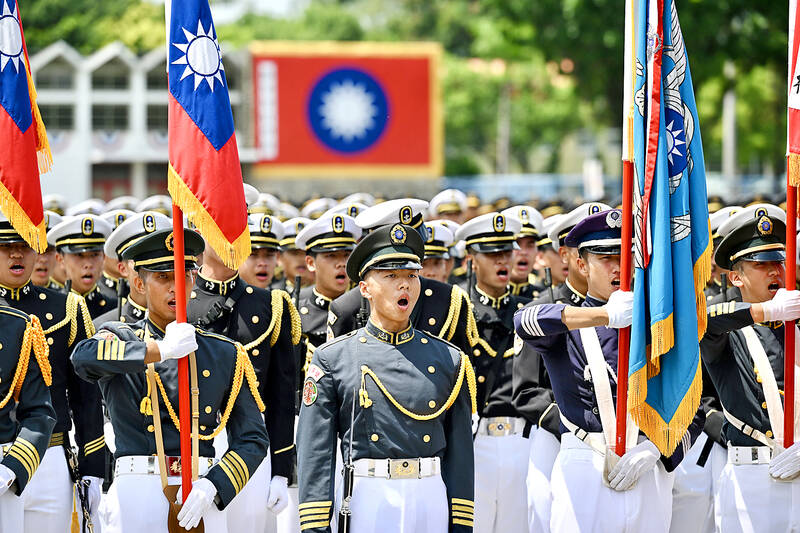
Photo: Lo Pei-de, Taipei Times
He appeared to be referencing remarks by former president Ma Ying-jeou (馬英九), who in 2020 said in a speech that China’s strategy is to mount a rapid invasion of Taiwan, leaving no time for the US to come to the nation’s rescue.
The academy was relocated to Taiwan after the Chinese Civil War and reopened in Kaohsiung as the Republic of China Military Academy. As the Chinese People’s Liberation Army recruited graduates from the original academy, both nations held centennials to assert ownership of the institution’s heritage.
More than 10,000 active and retired officers had been expected at the event in Kaohsiung, while fewer than 100 were forecast to attend China’s version in Huangpu, also known as Whampoa, Veterans Affairs Council Minister Yen De-fa (嚴德發) had said.
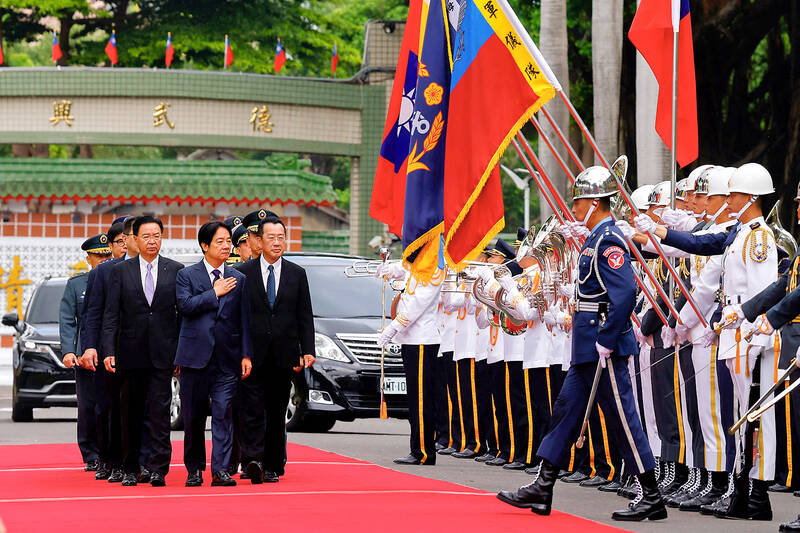
Photo: Ann Wang, Reuters
In Kaohsiung, students marched in step in a formal military parade — the first Lai has reviewed since taking office on May 20.
Legislative Speaker Han Kuo-yu (韓國瑜), National Security Council Secretary-General Joseph Wu (吳釗燮), Minister of National Defense Wellington Koo (顧立雄) and foreign dignitaries also attended the event.
Lai said he was honored to preside over the centennial as commander-in-chief.
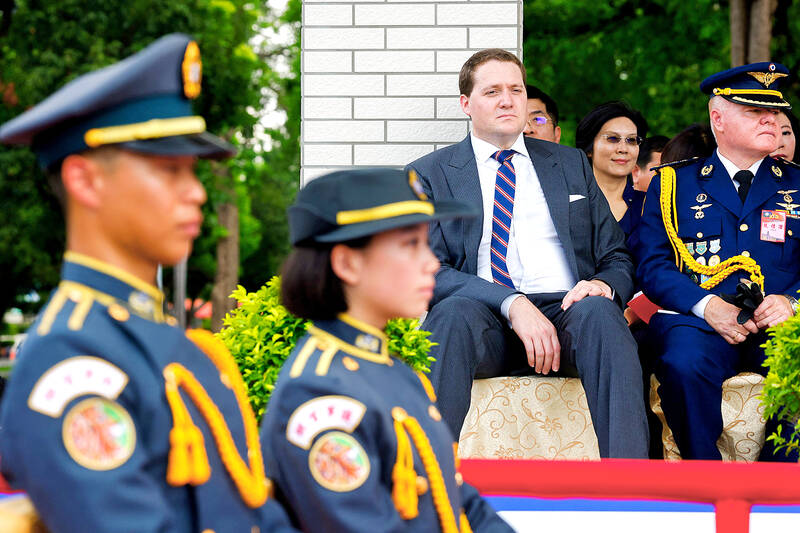
Photo: Ann Wang, Reuters
“The academy was established at a time when the country was in danger and was pressed on both domestic and international fronts. For a democratic republic of the people, by the people and for the people, young people joined the academy to fight wars to unite the nation, suppress communists and withstand the Japanese invasion. They were undaunted by hardships, difficulties and death,” Lai said.
Although the academy was relocated to Taiwan in 1949 following the Chinese Nationalist Party’s (KMT) loss to the Chinese Communist Party in the Chinese Civil War, it resumed operations in 1950 and defended Taiwan in the Second Taiwan Strait Crisis in 1958 and other conflicts, he said.
Students of the academy have also helped rebuild the nation after natural disasters, he added.
“Despite drastic changes over the past 100 years, we firmly believe that wherever the Republic of China is, there is the spirit of Whampoa... It is here that the spirit of Whampoa continues and prospers. Only those who would fight for the survival, development and security of the Republic of China and its people are true graduates of the academy, and those who have no such ambition are false ones,” he said.
The greatest challenge the academy’s students and graduates face is the rise of China and its intention to disrupt the “status quo” in the Taiwan Strait by annexing Taiwan and destroying the Republic of China, he said.
“Your highest commission should be to bravely defend Taiwan and maintain peace and stability across the Taiwan Strait,” he said.
Academy graduates need to realize they do not belong to any individual or political party, as they have pledged allegiance to the country, people and democracy, he said.
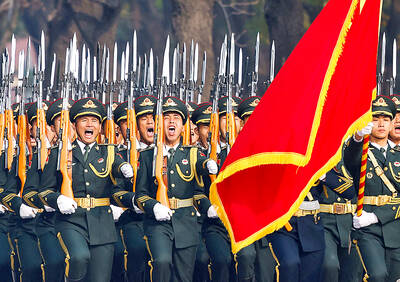
Conflict with Taiwan could leave China with “massive economic disruption, catastrophic military losses, significant social unrest, and devastating sanctions,” a US think tank said in a report released on Monday. The German Marshall Fund released a report titled If China Attacks Taiwan: The Consequences for China of “Minor Conflict” and “Major War” Scenarios. The report details the “massive” economic, military, social and international costs to China in the event of a minor conflict or major war with Taiwan, estimating that the Chinese People’s Liberation Army (PLA) could sustain losses of more than half of its active-duty ground forces, including 100,000 troops. Understanding Chinese

The Ministry of Foreign Affairs (MOFA) yesterday said it is closely monitoring developments in Venezuela, and would continue to cooperate with democratic allies and work together for regional and global security, stability, and prosperity. The remarks came after the US on Saturday launched a series of airstrikes in Venezuela and kidnapped Venezuelan President Nicolas Maduro, who was later flown to New York along with his wife. The pair face US charges related to drug trafficking and alleged cooperation with gangs designated as terrorist organizations. Maduro has denied the allegations. The ministry said that it is closely monitoring the political and economic situation

UNRELENTING: China attempted cyberattacks on Taiwan’s critical infrastructure 2.63 million times per day last year, up from 1.23 million in 2023, the NSB said China’s cyberarmy has long engaged in cyberattacks against Taiwan’s critical infrastructure, employing diverse and evolving tactics, the National Security Bureau (NSB) said yesterday, adding that cyberattacks on critical energy infrastructure last year increased 10-fold compared with the previous year. The NSB yesterday released a report titled Analysis on China’s Cyber Threats to Taiwan’s Critical Infrastructure in 2025, outlining the number of cyberattacks, major tactics and hacker groups. Taiwan’s national intelligence community identified a large number of cybersecurity incidents last year, the bureau said in a statement. China’s cyberarmy last year launched an average of 2.63 million intrusion attempts per day targeting Taiwan’s critical
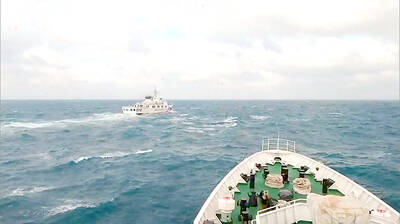
‘SLICING METHOD’: In the event of a blockade, the China Coast Guard would intercept Taiwanese ships while its navy would seek to deter foreign intervention China’s military drills around Taiwan this week signaled potential strategies to cut the nation off from energy supplies and foreign military assistance, a US think tank report said. The Chinese People’s Liberation Army (PLA) conducted what it called “Justice Mission 2025” exercises from Monday to Tuesday in five maritime zones and airspace around Taiwan, calling them a warning to “Taiwanese independence” forces. In a report released on Wednesday, the Institute for the Study of War said the exercises effectively simulated blocking shipping routes to major port cities, including Kaohsiung, Keelung and Hualien. Taiwan would be highly vulnerable under such a blockade, because it